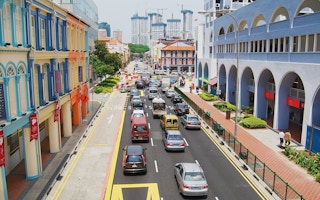The latest story to propel Singapore into the global limelight has been this curious incident of the Tesla car and the Land Transport Authority (LTA).
To continue reading, subscribe to Eco‑Business.
There's something for everyone. We offer a range of subscription plans.
- Access our stories and receive our Insights Weekly newsletter with the free EB Member plan.
- Unlock unlimited access to our content and archive with EB Circle.
- Publish your content with EB Premium.
Tesla Motors is an American premium electric vehicle (EV) manufacturer which has become a household name in Singapore since news broke earlier this month of how the first Tesla EV imported into Singapore by 44-year-old Joe Nguyen attracted a S$15,000 penalty from LTA.
The disgruntled Nguyen - who reportedly paid $400,000 to get his Tesla Model S on the road - wrote a blog detailing the arduous seven month-long process. His main grouse: Why did LTA penalise his EV, which has no tailpipe emissions, when so many other jurisdictions across the world offer rebates for similar vehicles?
The widely-reported incident even prompted a call from Tesla’s chief executive Elon Musk - a visionary tech entrepreneur who is also behind space exploration firm SpaceX - to our Prime Minister Lee Hsien Loong. Both of them had met during PM Lee’s trip to the US last month.
LTA is now reportedly working with Tesla engineers to assess if its test on the EV was conducted correctly.
The story has since generated a slew of comments and questions in its wake. These include: Is LTA’s method of testing EVs and including grid emissions correct? LTA derived the penalty it charged Mr Nguyen by calculating the emissions of the EV from a power consumption test and from the electricity used to charge it using the national grid.
Others have asked if the Tesla EV should enjoy tax rebates when it’s a high-performance car and whether Singapore should be embracing EVs?
To answer these questions, we need to look at the facts.
After remaining in relative obscurity for a century, EVs have soared in popularity in the past decade due to a combination of lower technology costs and increased government focus on cutting emissions and pollution.
Unlike conventional cars that run on internal combustion engines, EVs operate using batteries that are charged and have no tailpipe emissions. They help improve energy security by cutting reliance on transport fuels, and are a boon for cities, such as Beijing, that are plagued by smog since they do not emit any particulate matter.
“
Bloomberg New Energy Finance is predicting that the EV revolution could be more dramatic than governments and oil companies have yet realised. It published a study last month which estimated that by the 2020s, EVs will become a more economic option than petrol or diesel cars in most countries.
The drawbacks of EVs, however, include their limited driving range and expensive batteries, which critics say make their manufacturing process more resource-intensive. Despite this, multiple studies conducted in recent years that have compared the life-cycle environmental footprints of petrol cars versus those of EVs have generally shown that the latter perform better.
That is also why governments across the world are encouraging EV adoption by offering incentives to consumers. They view EVs - combined with renewable energy - as a key part of their energy strategy to slash carbon emissions, which will help them meet the commitments pledged under the recent Paris Agreement to tackle climate change.
Musk has publicly acknowledged that the world doesn’t need more high-performance cars, but Tesla’s strategy is to enter the high-end market - where customers can pay a premium - and use the revenue to drive down costs with each successive model so that EVs can some day become an affordable mass market option.
Ultimately, the biggest factor at play when determining if an EV has lower emissions is actually grid power, that is, how a country generates its electricity.
EVs that operate in a country powered by clean gas or renewables fare much better than, say, in a country powered mainly by coal. For instance, a 2013 study on “wells to wheels” emissions by a research group Shrink That Footprint found that Paraguay is the greenest place to make and drive an EV, whereas in India and China - where power generation is heavily coal-based - EVs have similar emissions to petrol vehicles.
In this sense, it is not wrong for LTA to consider grid emissions - the crucial thing is how they apply this calculation and to provide transparency on their testing methodologies.
They should also allow some flexibility to cater for situations where, say, a car is charged via solar-generated electricity - not a remote idea given the recent uptake of solar energy in Singapore.
LTA’s handling of this incident has also exposed a bigger issue - Singapore’s lack of knowledge and experience in EV technology.
For far too long, Singapore has ignored and lagged behind in the EV market and it does so to its own detriment.
Member of Parliament Ong Teng Koon noted in Parliament in January that EVs provide a rare opportunity in which “the (carbon) abatement cost would be voluntarily borne by consumers… rather than being paid for by the government.”
Already, Bloomberg New Energy Finance is predicting that the EV revolution could be more dramatic than governments and oil companies have yet realised. It published a study last month which estimated that by the 2020s, EVs will become a more economic option than petrol or diesel cars in most countries.
It forecasts that sales of EVs globally will hit 41 million by 2040, almost 90 times the equivalent figure for 2015, when EV sales are estimated to have been 462,000, some 60 per cent up on 2014.
This would have implications beyond the car market since such an increase in the demand for EVs will displace the use of crude oil and shift energy demand to electricity generation.
Governments will need to find ways to ensure their grids are prepared for a growing fleet of cars that will now be charged at home, while simultaneously integrating large amounts of renewable energy.
It is unclear if Singapore is prepared for this reality. It launched an EV test bed in 2011 but that remains in testing stage after five years and Singapore still has no EV infrastructure to speak of.
Some industry observers have suggested that Singapore has deliberately chosen to ignore EV technology because it plays host to several large oil refineries, which depend on petrol car owners as a key source of revenue. If that is true, then it seems to be a short-sighted decision.
But perhaps, all this won’t matter in the end. For all the brouhaha over EVs, the larger vision for the country is to be a “car-lite” nation, as outlined by PM Lee in the Sustainable Singapore Blueprint last year.
Singapore’s top priority should be to reduce the private car population as much as possible by making public transport affordable, reliable and accessible across the country. And where there is a need to use private cars, motorists should be encouraged to use the most efficient cars available, and share them as much as possible too.
I don’t think anyone could argue with that.
A version of this column was first published in The Straits Times.











